p.269
p.275
p.281
p.287
p.292
p.298
p.304
p.310
p.315
Heat Exchanger Network Optimization by Differential Evolution Method
Abstract:
The synthesis of heat exchanger network (HEN) is a comprehensive approach to optimize energy utilization in process industry. Recent developments in HEN synthesis (HENS) present several heuristic methods, such as Simulated Annealing (SA), Genetic Algorithm (GA), and Differential Evolution (DE). In this work, DE method for synthesis and optimization of HEN has been presented. Using DE combined with the concept of super-targeting, the optimization is determined. Then DE algorithm is employed to optimize the global cost function including the constraints, such as heat balance, the temperatures of process streams. A case study has been optimized using DE, generated structure of HEN and compared with networks obtained by other methods such as pinch technology or mathematical programming. Through the result, the proposed method has been illustrated that DE is able to apply in HEN optimization, with 16.7% increase in capital cost and 56.4%, 18.9% decrease in energy, global costs respectively.
Info:
Periodical:
Pages:
292-297
Citation:
Online since:
June 2014
Keywords:
Price:
Сopyright:
© 2014 Trans Tech Publications Ltd. All Rights Reserved
Share:
Citation:


